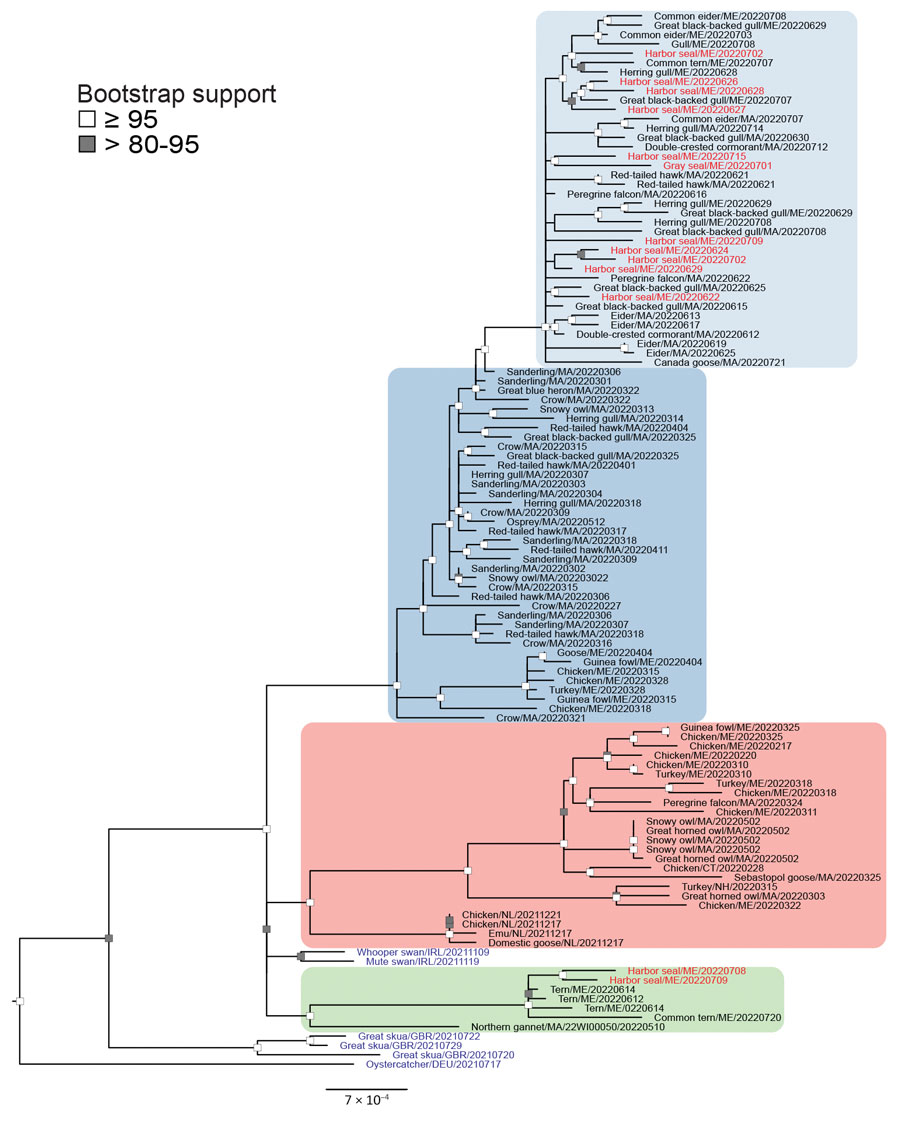Highly Pathogenic Avian Influenza A(H5N1) Virus Outbreak in New England Seals, United States
Wendy Puryear
1
, Kaitlin Sawatzki
1, Nichola Hill, Alexa Foss, Jonathon J. Stone, Lynda Doughty, Dominique Walk, Katie Gilbert, Maureen Murray, Elena Cox, Priya Patel, Zak Mertz, Stephanie Ellis, Jennifer Taylor, Deborah Fauquier, Ainsley Smith, Robert A. DiGiovanni, Adriana van de Guchte, Ana Silvia Gonzalez-Reiche, Zain Khalil, Harm van Bakel, Mia K. Torchetti, Kristina Lantz, Julianna B. Lenoch, and Jonathan Runstadler
Author affiliations: Tufts University Cummings School of Veterinary Medicine, North Grafton, Massachusetts, USA (W. Puryear, K. Sawatzki, A. Foss, J.J. Stone, M. Murray, E. Cox, J. Runstadler); University of Massachusetts, Boston, Massachusetts, USA (N. Hill); Marine Mammals of Maine, Brunswick, Maine, USA (L. Doughty, D. Walk, K. Gilbert); New England Wildlife Centers, Barnstable, Massachusetts, USA (P. Patel, Z. Mertz); New England Wildlife Centers, Weymouth, Massachusetts, USA (Z. Mertz); Wild Care, Inc., Eastham, Massachusetts, USA (S. Ellis, J. Taylor); National Oceanic and Atmospheric Administration Fisheries, Silver Spring, Maryland, USA (D. Fauquier); National Oceanic and Atmospheric Administration Fisheries, Gloucester, Massachusetts, USA (A. Smith); Atlantic Marine Conservation Society, Hampton Bays, New York, USA (R.A. DiGiovanni Jr.); Mount Sinai Icahn School of Medicine, New York, New York, USA (A. van de Guchte, A.S. Gonzalez-Reiche, Z. Khalil, H. van Bakel); US Department of Agriculture Animal and Plant Health Inspection Service, Ames, Iowa, USA (M.K. Torchetti, K. Lantz); US Department of Agriculture Animal and Plant Health Inspection Service, Fort Collins, Colorado, USA (J.B. Lenoch)
Main Article
Figure 1

Figure 1. Phylogenetic analysis of highly pathogenic avian influenza A(H5N1) viruses from New England birds and seals, United States. Complete genomes of HPAI H5N1 viruses (GISAID database, https://www.gisaid.org) were compared by using IQ-TREE (https://www.iqtree.org) with the Ultrafast bootstrap (n = 10,000) option and A/chicken/NL/FAV-0033/2021 as a reference. Bootstrap support values >80 are shown at nodes. Red text indicates seal-derived sequences, black text avian-derived sequences from New England and Newfoundland, and blue text indicates avian-derived sequences from Europe . Branches are shaded on the basis of lineage groups: primary lineage from North America, pink; New England–specific lineage A, 1st wave blue, 2nd wave light blue; and New England–specific lineage B, green. All newly reported specimens were collected in the New England region during February–July 2022. Scale bar indicates nucleotide substitutions per site.
Main Article
Page created: January 28, 2023
Page updated: March 21, 2023
Page reviewed: March 21, 2023
The conclusions, findings, and opinions expressed by authors contributing to this journal do not necessarily reflect the official position of the U.S. Department of Health and Human Services, the Public Health Service, the Centers for Disease Control and Prevention, or the authors' affiliated institutions. Use of trade names is for identification only and does not imply endorsement by any of the groups named above.
